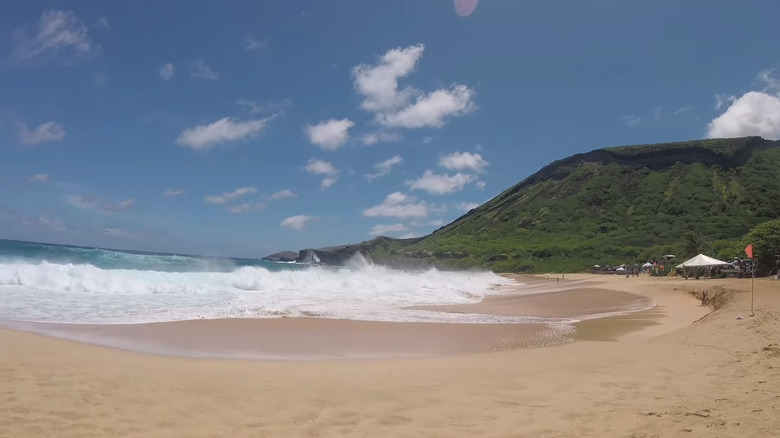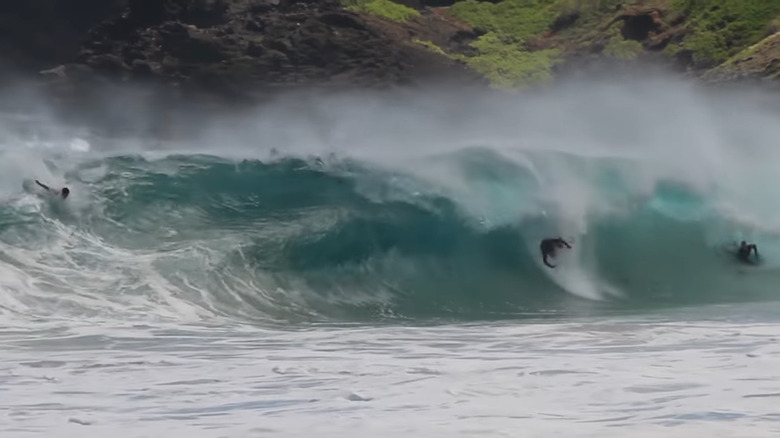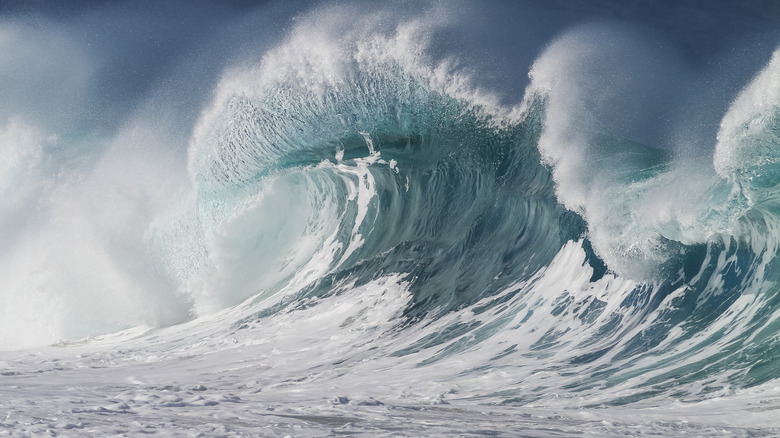The Unsettling Reason This Hawaiian Beach Has Such A Horrifying Nickname
With staggeringly blue waves, rolling sands, and views of dark, rocky cliffs coated in lush greenery, there's no denying that Oahu's Sandy Beach is beautiful. However, if you watch the water long enough, you'll see swimmers and surfers being tossed around like children's bath toys by the waves. Even rave reviews from travelers whom this Hawaiian beach has enchanted tend to contain a warning — be careful in the water. Don't go in unless you're experienced. Stay safe. This spot is nicknamed "Broke Neck Beach," and its waves can have devastating consequences.
Daredevils and thrill seekers come to Sandy Beach to experience the powerful waves for themselves, but unfortunately, visitors can end up seriously injured or even getting killed by the shore breaks. As reported by ABC10 in 2016, one tourist who had gone to the beach in hopes of seeing gorgeous landscapes while swimming in the ocean was fully paralyzed after the powerful tide broke his neck. It isn't just the uninformed who are at risk, though. In 2015, famed firefighter Yurik Resetnikov, who had bodysurfed on Sandy Beach many, many times, was also paralyzed. According to Honolulu Civil Beat, lifeguards stationed at Broke Neck Beach must rescue an average of 2-3 swimmers daily. Despite this, the beach continues to see more tourists every year.
Why is Sandy Beach so dangerous?
Shore breaks like those found at Sandy Beach are extremely dangerous to anyone caught in their path. The bigger they are, the more damage they do. While waves like this happen in many places, beaches in Hawaii are considered among the world's most dangerous because of how often these deadly waves occur there. Sandy Beach is especially infamous for shore breaks.
Sandy Beach gained its reputation for breaking necks because the waves come close to shore, catching beachgoers in the shallows. Many visitors feel safe closer to dry land, but this detail makes Sandy Beach so deadly. Usually, when you get caught in a wave, you might get sucked under, picked up, and thrown around by the water, which can certainly be dangerous. However, at Broke Neck Beach, you're more likely to be picked up and thrown back into the sand, potentially snapping your neck or damaging your spinal cord.
How to stay safe
Some of the most fun activities tourists come to Hawaii for can be the most dangerous. Swimming, snorkeling, and surfing are favorite pastimes for tourists and locals alike, but they can come with serious risks. Generally, it's unsafe to go into the water at Broke Neck Beach, but if you have significant experience and are determined to try, you should always check with one of the lifeguards on duty first to find out about the current conditions. It would also be best to make your visit an adults-only trip. Many Sandy Beach lifeguards like Kayla Kapuamohalanalani Chang do their best to warn away families. "I talk to the mom directly," she shared with Honolulu Civil Beat. "'For the safety of your kids, take them to another beach. There is permanent damage that can happen.'"
According to the National Weather Service, you can increase your chances of staying safe while swimming and snorkeling in Hawaii by keeping an eye on the state of the beach before your arrival. Don't let your guard down once you get there. Whether visiting Sandy Beach or another Hawaiian coastal spot, you should pay attention even if you don't plan to enter the water. As detailed by Hawaii.gov's ocean safety information, shore breaks at places like Sandy Beach can be hazardous to people in the waves and on the sand. Never face away from the ocean — you need to see any tall waves coming in.


